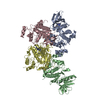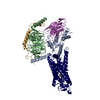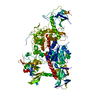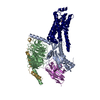[English] 日本語
 Yorodumi
Yorodumi- PDB-6vn7: Cryo-EM structure of an activated VIP1 receptor-G protein complex -
+ Open data
Open data
- Basic information
Basic information
| Entry | Database: PDB / ID: 6vn7 | |||||||||
|---|---|---|---|---|---|---|---|---|---|---|
| Title | Cryo-EM structure of an activated VIP1 receptor-G protein complex | |||||||||
 Components Components |
| |||||||||
 Keywords Keywords | SIGNALING PROTEIN / Vasoactive intestinal polypeptide receptor / VIP1R / G protein-coupled receptor / Gs protein / cryo-EM structure | |||||||||
| Function / homology |  Function and homology information Function and homology informationpituitary adenylate cyclase activating polypeptide activity / vasoactive intestinal polypeptide receptor activity / positive regulation of chemokine (C-C motif) ligand 5 production / positive regulation of growth hormone secretion / NGF-independant TRKA activation / regulation of G protein-coupled receptor signaling pathway / neuropeptide hormone activity / G protein-coupled peptide receptor activity / insulin secretion / peptide hormone receptor binding ...pituitary adenylate cyclase activating polypeptide activity / vasoactive intestinal polypeptide receptor activity / positive regulation of chemokine (C-C motif) ligand 5 production / positive regulation of growth hormone secretion / NGF-independant TRKA activation / regulation of G protein-coupled receptor signaling pathway / neuropeptide hormone activity / G protein-coupled peptide receptor activity / insulin secretion / peptide hormone receptor binding / PKA activation in glucagon signalling / peptide hormone binding / hair follicle placode formation / G protein-coupled receptor signaling pathway, coupled to cyclic nucleotide second messenger / negative regulation of cell cycle / developmental growth / neuropeptide signaling pathway / D1 dopamine receptor binding / positive regulation of protein kinase activity / intracellular transport / renal water homeostasis / Hedgehog 'off' state / adenylate cyclase-activating adrenergic receptor signaling pathway / activation of adenylate cyclase activity / cellular response to glucagon stimulus / cAMP-mediated signaling / adenylate cyclase activator activity / regulation of insulin secretion / positive regulation of GTPase activity / trans-Golgi network membrane / female pregnancy / negative regulation of inflammatory response to antigenic stimulus / bone development / G-protein beta/gamma-subunit complex binding / Olfactory Signaling Pathway / adenylate cyclase-modulating G protein-coupled receptor signaling pathway / Activation of the phototransduction cascade / adenylate cyclase-activating G protein-coupled receptor signaling pathway / G beta:gamma signalling through PLC beta / Presynaptic function of Kainate receptors / Thromboxane signalling through TP receptor / G protein-coupled acetylcholine receptor signaling pathway / G protein activity / G-protein activation / platelet aggregation / Activation of G protein gated Potassium channels / Inhibition of voltage gated Ca2+ channels via Gbeta/gamma subunits / Prostacyclin signalling through prostacyclin receptor / Glucagon signaling in metabolic regulation / G beta:gamma signalling through CDC42 / cognition / G beta:gamma signalling through BTK / ADP signalling through P2Y purinoceptor 12 / Sensory perception of sweet, bitter, and umami (glutamate) taste / Synthesis, secretion, and inactivation of Glucagon-like Peptide-1 (GLP-1) / photoreceptor disc membrane / Glucagon-type ligand receptors / Adrenaline,noradrenaline inhibits insulin secretion / Vasopressin regulates renal water homeostasis via Aquaporins / G alpha (z) signalling events / Glucagon-like Peptide-1 (GLP1) regulates insulin secretion / cellular response to catecholamine stimulus / ADORA2B mediated anti-inflammatory cytokines production / sensory perception of taste / ADP signalling through P2Y purinoceptor 1 / G beta:gamma signalling through PI3Kgamma / adenylate cyclase-activating dopamine receptor signaling pathway / Cooperation of PDCL (PhLP1) and TRiC/CCT in G-protein beta folding / GPER1 signaling / cellular response to prostaglandin E stimulus / neuron projection development / Inactivation, recovery and regulation of the phototransduction cascade / G-protein beta-subunit binding / heterotrimeric G-protein complex / sensory perception of smell / G alpha (12/13) signalling events / extracellular vesicle / signaling receptor complex adaptor activity / Thrombin signalling through proteinase activated receptors (PARs) / cell-cell signaling / GTPase binding / positive regulation of cold-induced thermogenesis / regulation of protein localization / retina development in camera-type eye / Ca2+ pathway / phospholipase C-activating G protein-coupled receptor signaling pathway / positive regulation of cytosolic calcium ion concentration / G alpha (i) signalling events / fibroblast proliferation / G alpha (s) signalling events / Hydrolases; Acting on acid anhydrides; Acting on GTP to facilitate cellular and subcellular movement / G alpha (q) signalling events / perikaryon / Ras protein signal transduction / cell population proliferation / Extra-nuclear estrogen signaling / positive regulation of ERK1 and ERK2 cascade / receptor complex / cell surface receptor signaling pathway / neuron projection Similarity search - Function | |||||||||
| Biological species |  Homo sapiens (human) Homo sapiens (human)synthetic construct (others) | |||||||||
| Method | ELECTRON MICROSCOPY / single particle reconstruction / cryo EM / Resolution: 3.2 Å | |||||||||
 Authors Authors | Duan, J. / Shen, D.-D. / Zhou, X.E. / Liu, Q.-F. / Zhuang, Y.-W. / Zhang, H.-B. / Xu, P.-Y. / Ma, S.-S. / He, X.-H. / Melcher, K. ...Duan, J. / Shen, D.-D. / Zhou, X.E. / Liu, Q.-F. / Zhuang, Y.-W. / Zhang, H.-B. / Xu, P.-Y. / Ma, S.-S. / He, X.-H. / Melcher, K. / Zhang, Y. / Xu, H.E. / Yi, J. | |||||||||
| Funding support |  China, 2items China, 2items
| |||||||||
 Citation Citation |  Journal: Nat Commun / Year: 2020 Journal: Nat Commun / Year: 2020Title: Cryo-EM structure of an activated VIP1 receptor-G protein complex revealed by a NanoBiT tethering strategy. Authors: Jia Duan / Dan-Dan Shen / X Edward Zhou / Peng Bi / Qiu-Feng Liu / Yang-Xia Tan / You-Wen Zhuang / Hui-Bing Zhang / Pei-Yu Xu / Si-Jie Huang / Shan-Shan Ma / Xin-Heng He / Karsten Melcher / ...Authors: Jia Duan / Dan-Dan Shen / X Edward Zhou / Peng Bi / Qiu-Feng Liu / Yang-Xia Tan / You-Wen Zhuang / Hui-Bing Zhang / Pei-Yu Xu / Si-Jie Huang / Shan-Shan Ma / Xin-Heng He / Karsten Melcher / Yan Zhang / H Eric Xu / Yi Jiang /   Abstract: Vasoactive intestinal polypeptide receptor (VIP1R) is a widely expressed class B G protein-coupled receptor and a drug target for the treatment of neuronal, metabolic, and inflammatory diseases. ...Vasoactive intestinal polypeptide receptor (VIP1R) is a widely expressed class B G protein-coupled receptor and a drug target for the treatment of neuronal, metabolic, and inflammatory diseases. However, our understanding of its mechanism of action and the potential of drug discovery targeting this receptor is limited by the lack of structural information of VIP1R. Here we report a cryo-electron microscopy structure of human VIP1R bound to PACAP27 and Gs heterotrimer, whose complex assembly is stabilized by a NanoBiT tethering strategy. Comparison with other class B GPCR structures reveals that PACAP27 engages VIP1R with its N-terminus inserting into the ligand binding pocket at the transmembrane bundle of the receptor, which subsequently couples to the G protein in a receptor-specific manner. This structure has provided insights into the molecular basis of PACAP27 binding and VIP receptor activation. The methodology of the NanoBiT tethering may help to provide structural information of unstable complexes. | |||||||||
| History |
|
- Structure visualization
Structure visualization
| Movie |
 Movie viewer Movie viewer |
|---|---|
| Structure viewer | Molecule:  Molmil Molmil Jmol/JSmol Jmol/JSmol |
- Downloads & links
Downloads & links
- Download
Download
| PDBx/mmCIF format |  6vn7.cif.gz 6vn7.cif.gz | 239.1 KB | Display |  PDBx/mmCIF format PDBx/mmCIF format |
|---|---|---|---|---|
| PDB format |  pdb6vn7.ent.gz pdb6vn7.ent.gz | 182.5 KB | Display |  PDB format PDB format |
| PDBx/mmJSON format |  6vn7.json.gz 6vn7.json.gz | Tree view |  PDBx/mmJSON format PDBx/mmJSON format | |
| Others |  Other downloads Other downloads |
-Validation report
| Summary document |  6vn7_validation.pdf.gz 6vn7_validation.pdf.gz | 1.3 MB | Display |  wwPDB validaton report wwPDB validaton report |
|---|---|---|---|---|
| Full document |  6vn7_full_validation.pdf.gz 6vn7_full_validation.pdf.gz | 1.3 MB | Display | |
| Data in XML |  6vn7_validation.xml.gz 6vn7_validation.xml.gz | 34 KB | Display | |
| Data in CIF |  6vn7_validation.cif.gz 6vn7_validation.cif.gz | 51.3 KB | Display | |
| Arichive directory |  https://data.pdbj.org/pub/pdb/validation_reports/vn/6vn7 https://data.pdbj.org/pub/pdb/validation_reports/vn/6vn7 ftp://data.pdbj.org/pub/pdb/validation_reports/vn/6vn7 ftp://data.pdbj.org/pub/pdb/validation_reports/vn/6vn7 | HTTPS FTP |
-Related structure data
| Related structure data |  21249MC M: map data used to model this data C: citing same article ( |
|---|---|
| Similar structure data |
- Links
Links
- Assembly
Assembly
| Deposited unit | 
|
|---|---|
| 1 |
|
- Components
Components
-Guanine nucleotide-binding protein ... , 3 types, 3 molecules ABG
| #3: Protein | Mass: 45727.441 Da / Num. of mol.: 1 Source method: isolated from a genetically manipulated source Source: (gene. exp.)  Homo sapiens (human) / Gene: GNAS, GNAS1, GSP / Production host: Homo sapiens (human) / Gene: GNAS, GNAS1, GSP / Production host:  |
|---|---|
| #4: Protein | Mass: 41055.867 Da / Num. of mol.: 1 Source method: isolated from a genetically manipulated source Source: (gene. exp.)  Homo sapiens (human) / Gene: GNB1 / Production host: Homo sapiens (human) / Gene: GNB1 / Production host:  |
| #5: Protein | Mass: 7861.143 Da / Num. of mol.: 1 Source method: isolated from a genetically manipulated source Source: (gene. exp.)  Homo sapiens (human) / Gene: GNG2 / Production host: Homo sapiens (human) / Gene: GNG2 / Production host:  |
-Protein / Protein/peptide / Antibody , 3 types, 3 molecules RLN
| #1: Protein | Mass: 66245.188 Da / Num. of mol.: 1 Source method: isolated from a genetically manipulated source Source: (gene. exp.)  Homo sapiens (human) / Gene: VIPR1 / Production host: Homo sapiens (human) / Gene: VIPR1 / Production host:  |
|---|---|
| #2: Protein/peptide | Mass: 3154.642 Da / Num. of mol.: 1 / Source method: obtained synthetically / Source: (synth.)  Homo sapiens (human) / References: UniProt: P18509 Homo sapiens (human) / References: UniProt: P18509 |
| #6: Antibody | Mass: 14714.320 Da / Num. of mol.: 1 Source method: isolated from a genetically manipulated source Source: (gene. exp.) synthetic construct (others) / Production host:  |
-Non-polymers , 2 types, 10 molecules 


| #7: Chemical | ChemComp-CLR / #8: Chemical | ChemComp-PLM / |
|---|
-Details
| Has ligand of interest | N |
|---|---|
| Has protein modification | Y |
-Experimental details
-Experiment
| Experiment | Method: ELECTRON MICROSCOPY |
|---|---|
| EM experiment | Aggregation state: PARTICLE / 3D reconstruction method: single particle reconstruction |
- Sample preparation
Sample preparation
| Component | Name: PACAP27-VIP1R-Gs protein complex stabilized by Nanobody 35 and NanoBiT system Type: COMPLEX / Entity ID: #1-#6 / Source: RECOMBINANT |
|---|---|
| Source (natural) | Organism:  Homo sapiens (human) Homo sapiens (human) |
| Source (recombinant) | Organism:  |
| Buffer solution | pH: 8 |
| Specimen | Embedding applied: NO / Shadowing applied: NO / Staining applied: NO / Vitrification applied: YES |
| Vitrification | Cryogen name: ETHANE |
- Electron microscopy imaging
Electron microscopy imaging
| Experimental equipment |  Model: Titan Krios / Image courtesy: FEI Company |
|---|---|
| Microscopy | Model: FEI TITAN KRIOS |
| Electron gun | Electron source:  FIELD EMISSION GUN / Accelerating voltage: 300 kV / Illumination mode: FLOOD BEAM FIELD EMISSION GUN / Accelerating voltage: 300 kV / Illumination mode: FLOOD BEAM |
| Electron lens | Mode: BRIGHT FIELD |
| Image recording | Electron dose: 64 e/Å2 / Film or detector model: GATAN K2 SUMMIT (4k x 4k) |
- Processing
Processing
| CTF correction | Type: PHASE FLIPPING AND AMPLITUDE CORRECTION |
|---|---|
| 3D reconstruction | Resolution: 3.2 Å / Resolution method: FSC 0.143 CUT-OFF / Num. of particles: 131263 / Symmetry type: POINT |
 Movie
Movie Controller
Controller












 PDBj
PDBj




























